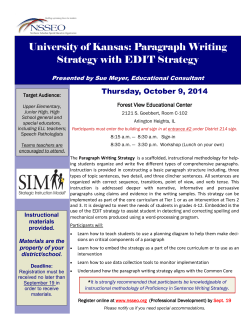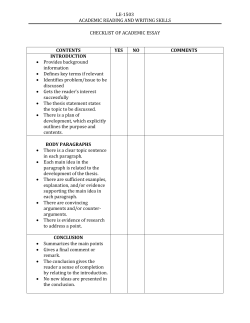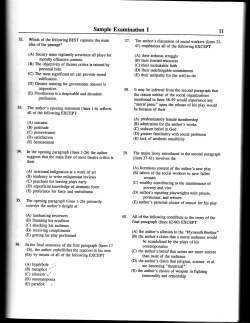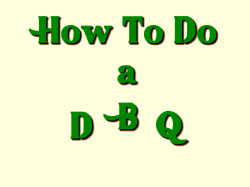
Paragraph Writing Cue Cards
Paragraph Topic List • My Favorite Sport • The Problems of Old Age • The Life of a Teenager • The Perfect Job • The “MUSTS” for a Healthy Body • The Best Season of the Year Pretest Sample Assignment: Describe what your life will be like in two years. In two years, I will be cramming for final exams while I finish my freshman year in college. In order that I do well on the exams, I will review my past exams. I will pick my most important goal, and I will decide on a major. I will relax and look forward to next year. Cue Card #1 Practice Sample Assignment: Describe someone My Special Friend Eric is very special to me. One reason Eric is special is that he is my best friend; he is always there for me. When I am upset, he listens and helps me solve my problems. In fact, he is my sunshine on a rainy day; he always lifts my spirit when it is down. Another reason he is special is that he always shows me respect. He never forgets my feelings, and he often puts my feelings first. A third reason Eric is special is that he is a very kind person, and he spreads his kindness generously. He is always doing favors for people without being asked. To summarize, Eric is special because he is always there for me, respects my feelings, and is very kind. Cue Card #2 Parts of a Paragraph Title Introduction Body Conclusion Cue Card #3 Sentence Types Used in Paragraphs Paragraph Part Sentence Type Introduction Topic Sentence Body Detail Sentences Conclusion Clincher Sentence Cue Card #4 The Paragraph Writing Strategy Puzzle: Part I Cue Card #5 Topic Sentence • Is usually the first sentence • Introduces the main idea • Sometimes introduces the details Cue Card #6 Types of Topic Sentences General Topic Sentences Clueing Topic Sentences Specific Topic Sentences Cue Card #7 General Topic Sentence Names the main idea of the paragraph. Cue Card #8 General Topic Sentence Cue Card #9 Examples of General Topic Sentences • The hot trend in advertising these days is to hire real, live stars. • Kevin James would have been 20 years old this September. • Not much is left of a town known as Nora, Nebraska. • Democracy is thriving at Hillsboro High School. Cue Card #10 Clueing Topic Sentence • Names the main idea. • Gives a clue about the details. Cue Card #11 Clue Words Many Various Differences Several Classes Similarities A number of Categories Advantages Number (“Three”) Groups Disadvantages Kinds Steps Jobs Types Stages Uses Parts Ways Causes Elements Roles Effects Pieces Features Reasons Members Examples Sources Divisions Characteristics Products Components Functions Variety Different Assortment Cue Card #12 Examples of Clueing Topic Sentences • The four seasons spice up our lives. • Tents come in a variety of shapes and sizes. • The citizens of Lawrence have several reasons for building a new high school. • Jesse Flynn is my best friend because of his many fine characteristics. Cue Card #13 Clueing Topic Sentence Cue Card #14 Specific Topic Sentence • Names the main idea. • Names the specific details to be covered. Cue Card #15 Specific Topic Sentence Cue Card #16 Examples of Specific Topic Sentences • Air pollution is caused by vehicles and industries. • Charles Darwin lived an interesting life as an explorer, writer, and scientist. • Diseases caused by vitamin deficiencies are beri beri, pellagra, scurvy, and rickets. Cue Card #17 Steps for Writing a Topic Sentence Pick a sentence type and a formula. Explore words to fit the sentence type and formula. Note the words. Search and check. Cue Card #18 The Paragraph Writing Strategy Puzzle: Part II Cue Card #19 Detail Sentence • Discusses one of the details in the paragraph • Sometimes shows the relationship between a detail and the rest of the paragraph Cue Card #20 The Paragraph Express Cue Card #21 Transition • Signals the introduction of a new detail. • Shows the relationship between the detail and the rest of the paragraph. Cue Card #22 Types of Detail Sentences Lead-off Sentences Follow-up Sentences Cue Card #23 Lead-off Sentence • Introduces a new detail • Contains a transition Cue Card #24 Follow-up Sentence Provides more information about the detail. Cue Card #25 The Paragraph Express Cue Card #26 Example Detail Sentences Topic sentence: Turtles could not survive without their marvelous shells. Detail sentences: Most importantly, turtles’ shells serve as the base for their skeletons. Their backbones and ribs are attached to the flat bony plates of their shells. This skeleton provides shape for their bodies. Somewhat importantly, turtles’ shells serve as their portable homes. Turtles can live anywhere because they carry their homes with them. This is important for turtles since they move so slowly. Finally, turtles’ shells are important because the shells protect turtles from their enemies. Turtles who are in danger can pull their heads and legs into their hard shells to protect themselves from animals who might try to eat them. Cue Card #27 Requirements for a Detail Sentence Each detail sentence must: • Contain related information. • Be in a logical sequence with other sentences. • Include a transition if it introduces a new detail. • Be written from the same point of view as the other sentences • Be written in the same tense as the other sentences. Cue Card #28 Detail Sentence Sequences • Size Sequence – When details are larger/smaller than each other • Time Sequence – When some details occur before others in time • Space Sequence – When details are arranged in space in relation to each other • Importance Sequence – When some details are more important than others • Chain-Link Sequence – When details are related in pairs or not related in any of the Cue Card #29 above sequences Transitions Chart Size Transitions The largest The next largest The smallest Larger than Equal to Smaller than The smallest The next smallest The largest The small-sized The medium-sized The large-sized The tallest The shortest At the beginning of In the middle of At the end of Meanwhile Before In the meantime During After Afterwards By this time At the same time, At that instant, Soon thereafter, Simultaneously, Thereafter, Presently After a short time Immediately, First, Second, Third, Finally, In the morning, Before noon, In the afternoon, In the evening, Yesterday, Today, Tomorrow, The day after tomorrow, In the past, In the present, In the future, The next day,This year, Two weeks later, Six months later, Time Transitions First, Then, Next, At last, Now Soon Then Later The first A more recent The most recent The earliest Next year, In the next few years, The next earliest The most recent Cue Card #30 Transitions Chart (cont.) Space Transitions Behind On the edge of Beside In front West of High Over Toward Around Facing East of Against Under Throughout Near back of North of Alongside Below To the right of Side by side In the center South of Ahead of Beneath To the left of Close to Inside At the Here Low down On top of Next to Outside In There On the bottom At the top Down At the end of On Beyond On the corner By Up Between Above Farther on Importance Transitions The best The most important The first The best The next best Equally important More important than The next best The least best The next most important Most important The worst The least important Cue Card #30 Transitions Chart (cont.) Chain-Link Transitions On the one hand, On the other hand, Again, Besides, Moreover, The opposite of _ is_ On the contrary side To the contrary, In contrast, In spite of Despite the One example of For instance, Another example, A further example, For example, For another example, Still another In addition, In the same way, In fact, Additionally, Lastly, Similar to _ is_ Another similar _ is_ Likewise, Similarly, A dissimilar _ is_ In the first place, In the second place, In the third place, In other words In fact, Also, The first The second The third One Another A further Further, Furthermore, Because Since As Still, While Instead First, Second, third, Specifically, More specifically, In particular, The last Last Indeed, Although Even though Even if As a result, Consequently, Naturally, After all, Nevertheless, Nonetheless, Concluding Transitions To conclude, In conclusion, In summary, In sum, In brief, To sum up, To summarize, Thus, In short, As you can see, As a result, Finally, Therefore, Cue Card #30 Points of View Cue Card #31 Example Sentences Written in First Person Point of View • I went to the beach for a vacation with several friends. • We sunbathed, fished, watched the surfers, and swam. • I have solved a number of mysteries lately. • We recently moved to the country from the city; we love our new home. Cue Card #32 Example Sentences Written in Second Person Point of View • You should be sure to pack light when you go backpacking. • You will have a good trip if you are aware of some safety tips. • Never take heavy objects like extra shoes or cast iron fry pans on a backpacking trip. Cue Card #33 Example Sentences Written in Third Person Point of View • The boys went to a movie and then to a dance; they enjoyed themselves. • Scott, Chris, and Wallis became the best of friends. • The garden was filled with many fragrant and colorful flowers. • Each detail sentence must be related to the topic sentence. Cue Card #34 Point of View Chart First Person Second Person I You We You (understood) Subjects Sometimes Me in rest of My sentence Mine Us Our Ours Myself Ourselves Your Yours Yourself Yourselves Third Person He She It They The house One idea The boys, Marie, Jamie, Chris Him Her Them Himself Herself Themselves Itself His Hers Their Theirs Cue Card #35 What Point of View? • My house is brown and white, and it has a big porch on the front. • Your photograph of the mountains is beautiful. • You can come over to my house tomorrow night. • Yesterday, I visited my best friend and his brother. • My sister’s family includes her husband, her daughter, and her two sons. Cue Card #36 Tenses Cue Card #38 Tense Chart Tense Past Verb painted was painting had painted Present is painting paints Future will paint shall paint Cue Card #38 Example Sentences for Tense Past • Yesterday, the sun rose at 5:30 a.m. • On her vacation, Kathy swam in the ocean every day, and she ran along the beach each evening. Present • The sun is rising early this morning. • Kathy loves to swim in the ocean. Future • Tomorrow, we will watch the sun rise. • Next summer, Kathy will swim in the ocean again, and she will stay fit. Cue Card #39 A Finished Paragraph Diagram Cue Card #40 Steps for Writing a Detail Sentence Pick a formula. Explore words to include the detail and • a transition word if it introduces a new detail • the point of view • the tense Note the words. Search and check. Cue Card #41 The Paragraph Writing Strategy Puzzle: Part III Cue Card #42 Clincher Sentence • Is the last sentence in the paragraph • Closes the paragraph • Names the main idea of the paragraph • Sometimes summarizes or names the details of the paragraph • Is different from the Topic Sentence Cue Card #43 The Paragraph Express Cue Card #44 Example Paragraph Nonviolent protest has been a major force in the world. In the late 1940s and early 1950s, Mahatma Ghandi and his followers used nonviolent protest to gain independence for India from Britain. For the first time in decades, Indians had their own country. In the 1960s, Martin Luther King and his followers used nonviolent protest to gain rights for Blacks in America. Through nonviolent protest, they obtained rights that had been denied to them since the slaves had been freed, such as the right to sit anywhere on a bus, eat in any restaurant, and vote in elections. Thus, nonviolent protest has been successfully used by oppressed people to gain independence from other nations; it has also been used to gain personal rights and freedoms. Cue Card #45 Concluding Transitions Words that tell the reader that the paragraph is finished. Cue Card #46 Types of Clincher Sentences General Clincher Sentence Clueing Clincher Sentence Specific Clincher Sentence Cue Card #47 General Clincher Sentence • Summarizes the main idea of the paragraph. • Makes the reader think more about the topic Cue Card #48 Example General Clincher Sentences • In summary, these car models are my favorites. • To summarize, these are my favorite car models; what are yours? • In conclusion, when life gives you lemons, make lemonade. • Thus, if a person has approval from others, he may be less happy than if he has his own approval. • To conclude, this woman had many qualities that people should imitate daily. Cue Card #49 General Clincher Sentence Cue Card #50 Clueing Clincher Sentence • Names the main idea • Ties the details together with a clue word Cue Card #51 Clueing Clincher Sentence Cue Card #52 Example Clueing Clincher Sentences • In sum, these four events served as the spark that ignited the war. • To conclude, life can deal you many cards; it’s how you play them that counts. • In other words, several issues need to be considered before a person accepts a job offer. • In conclusion, plenty of serious reasons exist for staying away from drugs; ignoring them can endanger one’s health and life. Cue Card #53 Specific Clincher Sentence • Names the main idea • Names the specific details that were covered in the paragraph • Names the details in the order in which they were discussed Cue Card #54 Specific Clincher Sentence Cue Card #55 Example Specific Clincher Sentences • To conclude, making a snowman involves rolling the parts of his body, stacking the parts, and creating his face and clothes. • In effect, the people followed a clear course: They wrote a petition, held rallies, demanded a vote, and caused the law to be changed. • In summary, the environment is in danger because of our vehicles, our mountains of waste, and our lack of attention to nature’s need to replenish itself. Cue Card #56 Steps for Writing a Clincher Sentence Pick a sentence type and formula. Explore words to fit. Note the words. Search and check. Cue Card #57 Clincher Sentences Model Paragraph 1 A football team can score points in several ways. Anytime during a game, a football team can make six points by scoring a touchdown. A touchdown occurs when a player carries the football across the goal line or when the ball is successfully caught in the end zone. After a touchdown, a team can score additional points. One point can be made by kicking the ball through the goal posts; two points can be made by running the ball across the goal line or by successfully passing the ball into the end zone. Another way a team can score any time is by kicking a three-point field goal. A field goal is scored when a player kicks the football through the goal posts. Something that happens less often is that a team can score two points for a safety. This involves tackling the player who has the ball when he is inside his own team’s end zone. Cue Card #58 Clincher Sentences Model Paragraph 2 People are endangering the future lives of wild animals on our planet by taking land away from the animals, by taking the animals away from the land, by polluting the land and water, and by killing too many animals. First, people take land away from the animals to make room for houses and other buildings. They also use the land for farms and ranches. Second, people trap many animals each year for pets, and they put the animals in zoos or circuses. Third, people put tons of waste and garbage into the land, air, and water. This pollution is killing5, people are killing too many wild animals for food, for sport, for their furs, and for other parts of their bodies. Cue Card #59 Clincher Sentences Model Paragraph 3 How the dinosaurs died out is one of the greatest mysteries of all time. Some scientists think that a giant meteor from outer space hit the earth about 65 million years ago. Its impact could have caused many changes on the earth that might have killed the dinosaurs. For example, the meteor’s impact might have raised tons of dirt and dust into the atmosphere so that sunlight could not reach the earth, or it might have started the eruptions of many volcanoes or created tidal waves. Other scientists theorize that when flowering plants appeared in the world, the plant-eating dinosaurs could not digest these plants and died. In turn, the meat-eating dinosaurs also starved because there were no plant-eating dinosaurs left to eat. Still other scientists propose that a strange disease wiped out the dinosaurs. Finally, other scientists think that the climate of the world became too cold for the dinosaurs’ survival. Cue Card #60 The Paragraph Writing Strategy Puzzle: Part IV Cue Card #61 Steps for Writing a Paragraph Set up a diagram Create the title Reveal the topic Iron out the details Bind it together with a clincher Edit your work Cue Card #62 Types of Paragraphs Sequential Paragraph Expository Paragraph – Narrative Paragraph – Facts Paragraph – Step-by-Step Paragraph – Reasons Paragraph Descriptive Paragraph – Examples Paragraph Compare and Contrast Paragraph – Compare Paragraph – Contrast Paragraph Cue Card #63 – Compare and Contrast Paragraph
© Copyright 2025











